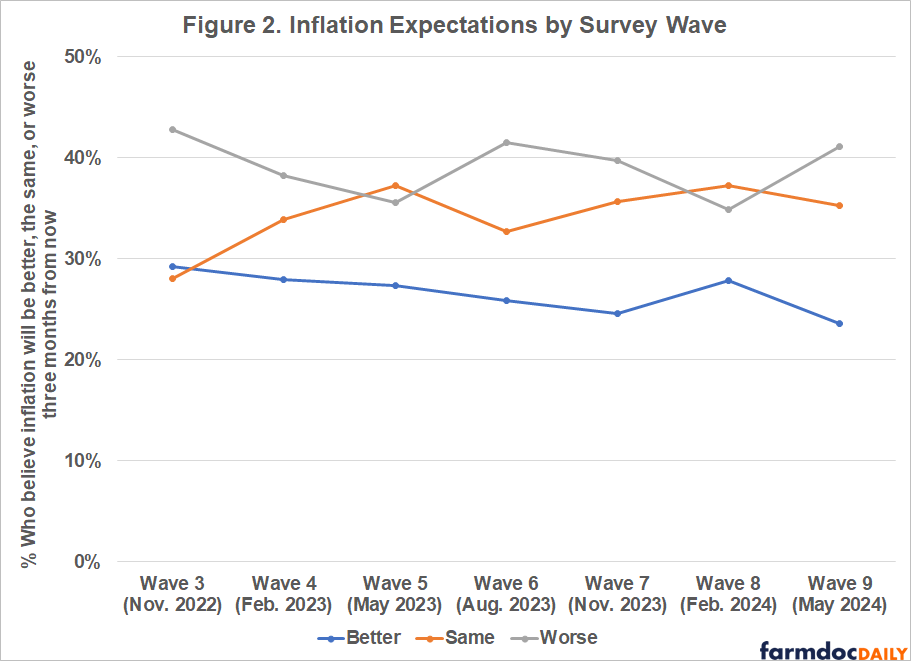Consumers Continue to Struggle with Inflation and Food Affordability: Results From GFAPS
Introduction
News headlines continue to highlight that inflation—the rate of increase in prices—is cooling but overall prices remain much higher than pre-pandemic levels (e.g., Wile, 2024; Peck, 2024; McCarthy, 2024). Because prices remain relatively high, it is unclear that consumers are feeling any relief. In this post, we look at data from the most recent wave (Wave 9, May 2024) of the Gardner Food and Agricultural Policy Survey to examine consumers’ perceptions of food affordability and views on inflation more generally.
Methods
The Gardner Food and Agricultural Policy Survey is a quarterly survey of U.S. consumers that is designed to track consumer sentiment on important food and agricultural policy issues. Each quarter, approximately 1,000 consumers are recruited; quota sampling is used to ensure the sample is nationally representative in terms of gender, age, income, and geographic region.
For this post, we focus on questions related to food affordability and inflation. Food affordability is one (of seven) dimensions of the food system that we track. For this, consumers were asked to what extent they agree or disagree (where 1=strongly agree and 5=strongly disagree) that our food system produces food that is affordable.
For inflation, we asked consumers to what extent they felt inflation affected them in the last month (0=not affected; 10=highly affected). Then we asked consumers about their expectations for inflation three months from now – will it get better, get worse, or stay the same?
Results
Perceptions of Food Affordability
Figure 1 shows the percentage of survey respondents who agreed or strongly agreed that our food system produces food that is affordable across the nine survey waves. Overall, the trend is declining, meaning the share of consumers who believe our food system is producing affordable food is shrinking. We observed a low of 49.0% agreement in Wave 6. While this recovered somewhat in Waves 7 and 8, perceptions of affordability in Wave 9 have dropped again, to 50.1% agreement. Relative to other dimensions of the food system such as taste, safety, accessibility, etc., affordability has seen the most movement over time.
Perceptions of Inflation
Consumers continued to report being affected by inflation, with an average score of 7.0 for Wave 9. When thinking about inflation three months from now, 41.1% of respondents expect that inflation will become worse, 35.3% expect it will stay the same, and 23.6% expect it will become better. Relative to previous survey waves (future expectations have been tracked since Wave 3), Figure 2 shows that this is the lowest share of respondents who believe inflation is improving. These results align with other consumer tracking surveys, for example, the Center for Food Demand Analysis and Sustainability at Purdue also found that consumers continue to expect food prices to rise in 2024 (Balagtas and Bryant, 2024).
Conclusions
Results from the most recent wave of the Gardner Food and Agricultural Policy Survey demonstrate that consumers perceive inflation and high food prices to be persistent problems, even though federal data suggest inflation is cooling. Consistent with this, a recent Gallup poll found that 41% of households identified inflation as the most important financial problem they are currently facing (Jones, 2024).
In response to consumer pushback on high prices, some retailers like Target, Walmart, Amazon, and Walgreens have announced they will be cutting prices on thousands of items (Gleeson, 2024). Major fast food chains such as McDonald’s, Wendy’s, and Burger King have also announced new, lower-priced value meals (Tuttle, 2024). However, it remains to be seen if this provides relief in the minds of consumers. Some policymakers are concerned these moves are not enough and have urged President Biden to take executive action to address this issue (Inklebarger, 2024).
As we look to November elections, inflation will be a key issue for voters. The Gardner Food and Agricultural Policy Survey will continue to monitor the public’s views on food affordability and experiences with inflation.
References
Balagtas, Joseph, and Elijah Bryant. 2024. Consumer Food Insights. Center for Food Demand Analysis and Sustainability. Volume 3, Issue 2. https://ag.purdue.edu/cfdas/wp-content/uploads/2024/03/Report_202402-1.pdf
Gleeson, Cailey. 2024. Walgreens joins Target, Amazon, Walmart in announcing steep summer price cuts. Forbes, May 29, https://www.forbes.com/sites/caileygleeson/2024/05/29/walgreens-joins-target-amazon-walmart-in-announcing-steep-summer-price-cuts/?sh=75aff17766ea. Accessed June 7, 2024.
Inklebarger, Timothy. 2024. Democrats call on Biden to investigate price gouging by grocers. Supermarket News, May 16, https://www.supermarketnews.com/news/democrats-call-biden-investigate-price-gouging-grocers. Accessed June 7, 2024.
Jones, Jeffrey M. 2024. Americans continue to name inflation as top financial problem. Gallup, May 2, https://news.gallup.com/poll/644690/americans-continue-name-inflation-top-financial-problem.aspx. Accessed June 7, 2024.
McCarthy, Kelly. 2024. New inflation data could signal cheaper grocery prices, more discounts, expert says. ABC News, May 15, https://abcnews.go.com/GMA/Food/new-inflation-data-signal-cheaper-grocery-prices-discounts/story?id=110260509. Accessed June 7, 2024.
Peck, Emily. 2024. Why grocery bills feel so high, even though food inflation is technically low. Axios, May 28, https://www.axios.com/2024/05/28/food-inflation-grocery-prices. Accessed June 7, 2024.
Tuttle, Brad. 2024. All the big grocery stores and fast food chains with special deals this summer. Money, May 31, https://money.com/grocery-stores-fast-food-cutting-prices/. Accessed June 7, 2024.
Wile, Rob. 2024. Rent up, groceries down: Inflation cooled slightly in April, but consumers still face a mixed bag. NBC News, May 14, https://www.nbcnews.com/business/consumer/inflation-where-prices-are-falling-food-rent-explainer-rcna152009. Accessed June 7, 2024.
Disclaimer: We request all readers, electronic media and others follow our citation guidelines when re-posting articles from farmdoc daily. Guidelines are available here. The farmdoc daily website falls under University of Illinois copyright and intellectual property rights. For a detailed statement, please see the University of Illinois Copyright Information and Policies here.









